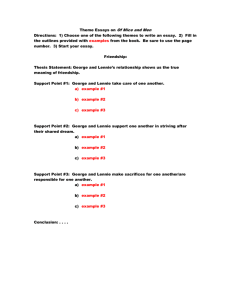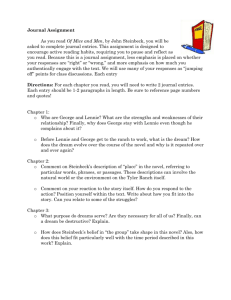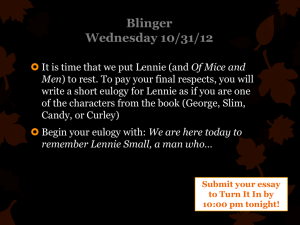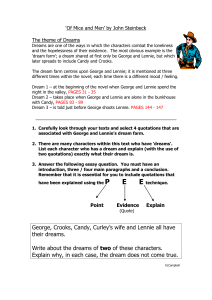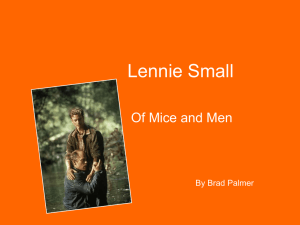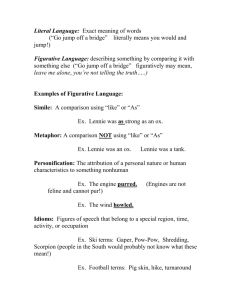The Modern Period
advertisement
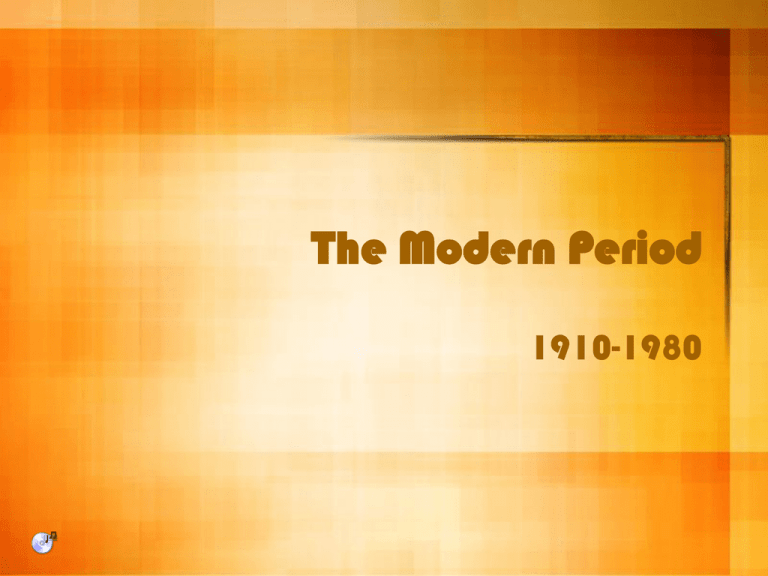
The Modern Period 1910-1980 John Cage 1912-1992 John Cage was inspired by Zen which is an Eastern philosophy He was very spontaneous when he created his work He would flip a coin to determine the length of the notes One of his works 4’33” is one of his famous pieces. It was 4 minutes and 33 seconds of silence “Totem Ancestor” One instrument predominates, the electric piano. One rhythm plays constantly throughout the song, establishing the tempo, which is moderately fast. The main melody has no pattern to it whatsoever. “Totem Ancestor” Continued… The articulation played is very pointed, very accented, and staccato (short). The dynamics change at least twice from medium loud to very loud The tempo speed changes about three times, at one time playing very fast, another time playing slow, and another time without a discernable tempo. Authors of the Modern Period: John Steinbeck (1902-1968) Examined the lives of struggling characters, esp. working class, and migrant workers during the Dust Bowl and Great Depression, and the idea of the “American Dream.” Uses mostly simple and compound sentences with little figurative language so as not to sugarcoat the situation, but to tell how life was for people during this time. Steinbeck’s portrayal of the American Dream In his work, Of Mice and Men, George and Lennie’s dream was to “get…[a] little place an’ live on the fatta the lan…” and be able to tend to rabbits (Lennie’s dream). His entire work presented the idea that even the best made plans can go awry Ernest Hemingway Uses short, choppy dialogue and doesn’t identify the speaker in his works, and experimented with taboo topics. Uses own experiences as an ambulance driver, and an expatriate in Paris as a base for A Farewell to Arms and The Sun Also Rises. Hemingway continued… In his short story, “Hills Like White Elephants,” Hemingway introduces the unheard-of topic of abortion indirectly. Even though the man in the story believes that “It's really an awfully simple operation…” and that “it's all perfectly natural,” the woman is still concerned because she wants to have the child, that she “could have everything…” Artists of the Modern Period: Edward Hopper Used defining, rich colors and smooth lines in both his oil and pastel paintings. New York Movie 1939 Hopper cont… His art was complex, detailed, and focused on one particular image, emphasizing the isolated feeling of the era Hotel Room 1931 Hopper cont… All portraits presented everyday events as they were without embellishing them. Hotel Lobby 1943 Sidney Goodman His subjects were portrayed as unfocused and isolated from each other. Figures in a Landscape 1972-1973 Goodman continued… Used dim, varying colors The Quick and the Dead 1980-1981 Goodman continued… Used smooth, not hard, lines. Night Burn 1986-1987 Georgia O’Keeffe (1887-1986) At first painted according to imitative realism, but changed to emphasize personal expression through the harmonious arrangement of line, color, and notan (Japanese system of lights and darks). Cottonwood III 1944 Georgia O’Keeffe (1887-1986) Known for her paintings of flowers, rocks, shells, animal bones, and landscapes, turning concrete objects into abstract images. Red Hills and Bones 1941 Georgia O’Keeffe (1887-1986) Painted smooth, curved forms with subtle tonal transitions of different bright colors. Pelvis Series – Red with Yellow 1945 Modern Connections Present the themes of aimlessness, loss of focus, the beauty and the dangerous reality of the world, the successes and the failures of the “American Dream.” – Ex. George and Lennie’s dream in Of Mice and Men, to own a farm and live on their own fails after George shoots Lennie, in an effort to spare him from a slow painful death at the hands of Curley after Lennie kills Curley’s wife. Modern Connections cont… Experimented with different techniques, some of which were risky in that they brought up controversial issues in their works. Other techniques proved to be very expressive of one’s mind. – Ex. O’Keeffe expressed her feelings toward nature and life in her painting Red Hills and Bones by showing the different stages of life through a richlycolored landscape. Modern Connections The method they used to present their ideas was often vague and left for interpretation by the reader. – Ex. Any of the examples of artwork shown in this presentation can be interpreted in many different ways. – John Cage’s composition can be interpreted as lacking any sense or as unique since no other song sounds like it. Modern Period Vocabulary Aimless Simplistic Vague Expressive Experimental Bright Vivid Reflective of the past Evolved Spontaneous
